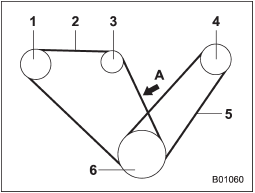Drive belts

1) Power steering oil pump pulley
2) Front side belt
3) Alternator pulley
4) Air conditioner compressor pulley
5) Rear side belt
6) Crank pulley
A) 22 lbf (98 N, 10 kgf)

The front side belt, which runs in conjunction with the following components, must be used within the specified deflection.
Х Power steering oil pump pulley
Х Alternator pulley
Х Crank pulley
Check the deflection of the front side belt and if there is any looseness, cracks, wear or unusual noise on the front side belt, contact your SUBARU dealer.
Continuing to use the vehicle with the belt outside of the specification may cause the engine to malfunction and the above components to malfunction.
To check the deflection of the front side belt, place a straightedge (ruler) across two adjacent pulleys (alternator pulley and crank pulley) and apply a force of 22 lbf (98 N, 10 kgf) midway between the pulleys by using a spring scale. The belt deflection should be the amount specified. If the front side belt is loose, cracked or worn, contact your SUBARU dealer.

The rear side belt is a stretch-type belt, therefore the deflection does not need to be checked. If there are cracks or wear confirmed on the belts and a squeaking noise is heard from them, contact your SUBARU dealer.
See also:
When selecting a CD to play (type B)
Disc select buttons
Press a desired one of the disc select buttons the disc number indicator of which
steadily lights up. The player will then start playback of the selected CD, beginning
with ...
Breaking-in of new brake pads and linings
When replacing the brake pad or lining, use only genuine SUBARU parts. After replacement, the new parts must be broken in as follows. ...
If you have accidentally triggered the alarm system
To stop the alarm
Perform any of the following operations.
● Press any button on the remote transmitter.
● Turn the ignition switch to the УONФ position. ...


